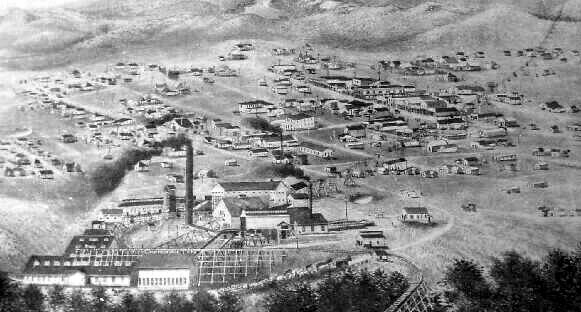
Encampment, Wyo., illustration by Merritt D. Houghton, 1903
The above view depicts Encampment shortly after the turn of the century.
Running from the Boston-Wyoming Smelter in the foreground, to the right and up is the world's longest
arial tramway bringing ore from the Rudefeha Mine discussed on the subsequent page.
Merritt Dana Houghton (1846-1918) from the 1880's until the time of his death in Seattle was a well known illustrator and
photographer of western scenes. He arrived in Laramie about 1875. By 1880 he was serving as superintendent of schools for Carbon County. He had
for a period of time a photographic and art studio in Rawlins. Thereafter, in the mid-1880's he toured the eastern part of the state taking commissions to
do drawing of ranches and places of business. He was the editor and illustrator of Wyoming Illustrated. A number of his illustrations appear in
Professor Charles Griffin Coutant's 1899 "The History of Wyoming."

Encampment, Wyo, 1901. Illustration by Merritt D. Houghton (attributed).
In 1904, the Encampment Herald published
two portfolios of his views of southern Wyoming consisting of both sketches and half-tones. The first portfolio, of which the top-most illustration was a
part was available for sale for $1.00 at the Herald office as well as the New Bohn hotel. Additionally, he published illustrations of northern Colorado.
In 1907, he obtained a commission for a European syndicate to provide illustrations of various western mines in
Idaho and Montana. Later he did illustrations of mines in Washington State.
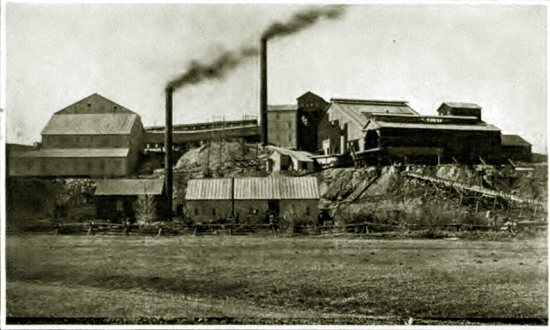
Penn-Wyoming Smelter, Encampment, Wyo., 1907
The smelter was constructed primarily of wood. The twelve wooden storage bins had a capacity of one hundred tons
of ore each.
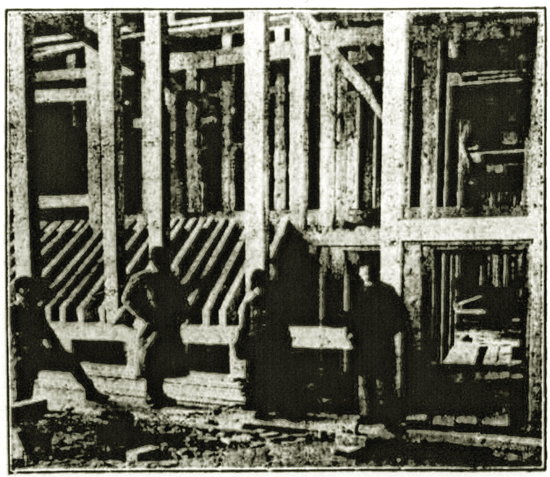
wooden fram work for the ore bins, Penn-Wyoming Smelter, Encampment, Wyo.
The history of the Grand Encampment Mining District is to a great extent the history of the schemes of lawyer, nowvelist and promotor Willis George Emerson and
the rise and fall of the
Ferris-Haggarty or Rudefeha Mine and the Penn-Wyoming Copper Company, capitalized at $10,000,000.00. Copper was discovered by Ed Haggarty in
1897 with his claim filed the following year. The first load of ore out of the area assayed at 33% copper.

Encampment, Wyo., looking south, 1908.
.jpg)
Encampment, Wyo., looking south, approx. 1940. Photo by William P. Sanborn.
In 1898, the town had a total of four buildings. Charles E. Winter in his novel, "Grandon of Sierra, described Encampment in its
formative years as a
small cluster of unpainted buildings and tents nestling near the foothills of the range five miles ahead.
* * * *
Rough, unpainted pine structures sagglingly filled
one block. Log houses mingled with the pine. Beyond the business street, shacks and tents were visible, scattered about as though
they had lit in a flock.A number of buildings were in course of construction and, unlike the
building of Solomon's temle, the sound of the hammer, the saw, the ax and the sledge mingled in
confusion.The creak of freight caravans of black and tan. The cowboy was clearly in the minority here,
but numerous members of his kind walked or rode through the streets with characteristic
freedom and grace, wearing the inevitable chaps and spurs.
Ten years later at its
peak, Encampment had a population of about 2,000. Three years later after the collapse of Penn-Wyoming, the town had a population of about
200. Other towns established in the Mining District, Battle, Dillon, Elwood, and Rambler faded from
existence.
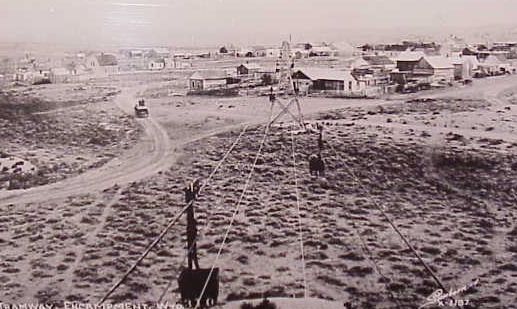
Aerial Tramway, Encampment, prior to 1908
The tramway was completed in 1902 with the first ore delivered in June, 1903.
The tramway had 370 towers and utilized 985 buckets traveling at 4 miles per hour to move the ore from
the mine at Battle, Wyo. There were three cable stations each approximately four miles apart.
The cable operation was powered by wood fired steam engines.
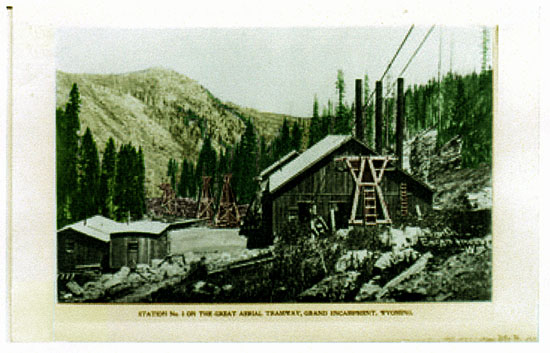
Cable Station no. 1, Grand Encampment Mining District, approx. 1903.
Haggerty's discovery of copper was not, however, the first discovery of mineral wealth in the area. As early as 1874 copper had
been discovered in the area. Gold bearing quartz had been discovered at what later became the Kurtze Chatterton Mine as early as 1864. Active mining
commenced across the border in Colorado near Hahn's Peak in the early 1870's with the formation of the
Hahn's Peak Gold & Silver Mining Company in 1874 and the Hahn's Peak Wagon Road Company two years later.
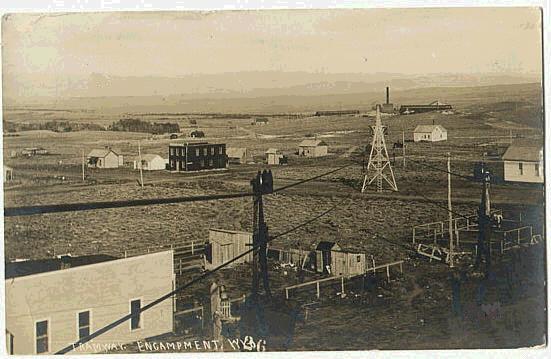
Aerial Tramway, Encampment, prior to 1908, Boston-Wyoming Smelter in the background.
Next page, Encampment continued.
|